|
Made With |
|
|
|
|
Dr. Hoffer's Travel WebSite This site was last updated 07/27/14 |
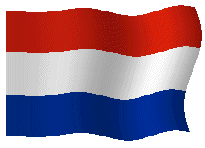
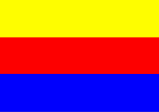
![]() WEST EU 09 #10 Finally
Holland
WEST EU 09 #10 Finally
Holland
![]()
Noord-Holland Flag
Friday June 12, 2009
![]() Here are some statistics on Den Bosch. The city is 35.2 mi2
(91.26 km2) with a population of 136,500 and a density 3,878/mi2
(1,496/km2.) The city's official
Here are some statistics on Den Bosch. The city is 35.2 mi2
(91.26 km2) with a population of 136,500 and a density 3,878/mi2
(1,496/km2.) The city's official
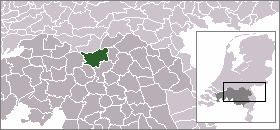 name
is a contraction of the Dutch "des Hertogen bosch" meaning "the Duke's forest".
The duke in question was Henry I, Duke of Brabant, whose family had owned a
large estate at nearby Orthen for at least four centuries. He founded a
new town located on some forested dunes in the middle of a marsh. At age
26, he granted 's-Hertogenbosch city rights and the later trade privileges in
1185. This is the traditional date given by later chroniclers. Its
original charter has been lost. His reason for founding the city was to protect
his own interests against encroachment from Gelre and Holland. From the
beginning he
name
is a contraction of the Dutch "des Hertogen bosch" meaning "the Duke's forest".
The duke in question was Henry I, Duke of Brabant, whose family had owned a
large estate at nearby Orthen for at least four centuries. He founded a
new town located on some forested dunes in the middle of a marsh. At age
26, he granted 's-Hertogenbosch city rights and the later trade privileges in
1185. This is the traditional date given by later chroniclers. Its
original charter has been lost. His reason for founding the city was to protect
his own interests against encroachment from Gelre and Holland. From the
beginning he
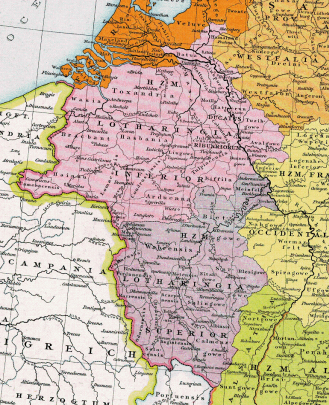 conceived of the city as a fortress. It was destroyed in 1203
in a joint expedition of Gelre and Holland, but was soon rebuilt. Some
remnants of the original city walls are still there. In the late
conceived of the city as a fortress. It was destroyed in 1203
in a joint expedition of Gelre and Holland, but was soon rebuilt. Some
remnants of the original city walls are still there. In the late
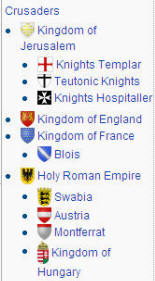 15th
Century, a much larger wall was erected to protect the greatly expanded city.
Artificial waterways were dug to serve as a city moat, through which the rivers Dommel and Aa were diverted. The city flourished until 1520, becoming the
second largest population centre in the territory of the present Netherlands,
after Utrecht.
15th
Century, a much larger wall was erected to protect the greatly expanded city.
Artificial waterways were dug to serve as a city moat, through which the rivers Dommel and Aa were diverted. The city flourished until 1520, becoming the
second largest population centre in the territory of the present Netherlands,
after Utrecht.
Henry I of Brabant (below) was probably born in Leuven in 1165 AD. 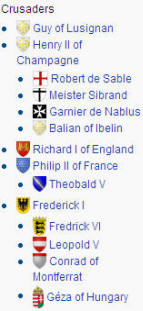 He became Duke of Brabant in 1183 and succeeded his father (Godfrey III) as Duke
of Lower Lotharingia in 1190
(pink area on
He became Duke of Brabant in 1183 and succeeded his father (Godfrey III) as Duke
of Lower Lotharingia in 1190
(pink area on
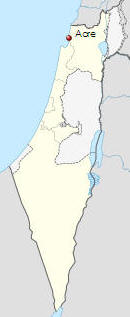 map
(north;) purple (south) is Upper Lotharingia later becoming Lorraine.) Henry was one of the leaders of the
Third
Crusade, which he joined in mid 1197. In that October, he took part in the
recapture of Beirut and then headed to Jaffa with the Crusaders. However,
before reaching the city he got news of the death of the King of Jerusalem,
Henry II of Champagne, so he returned to
Acre (photo below.) Here he acted as regent
until the arrival of the new King,
Amalric II. In 1208, after the
assassination of Philip of Swabia, King of the Romans, Henry was proposed as
successor by King Philip II Augustus. In the war which followed, he and
Germany emperor Otto IV, were defeated in the
Battle of Bouvines.
map
(north;) purple (south) is Upper Lotharingia later becoming Lorraine.) Henry was one of the leaders of the
Third
Crusade, which he joined in mid 1197. In that October, he took part in the
recapture of Beirut and then headed to Jaffa with the Crusaders. However,
before reaching the city he got news of the death of the King of Jerusalem,
Henry II of Champagne, so he returned to
Acre (photo below.) Here he acted as regent
until the arrival of the new King,
Amalric II. In 1208, after the
assassination of Philip of Swabia, King of the Romans, Henry was proposed as
successor by King Philip II Augustus. In the war which followed, he and
Germany emperor Otto IV, were defeated in the
Battle of Bouvines.

Under Henry I, Den Bosch had a town
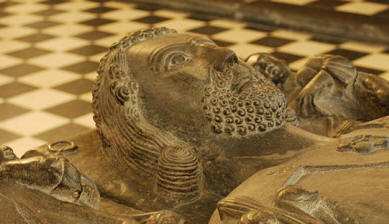 policy and town planning. Henry's
attention went out to those regions that lent themselves to the extension of his
sovereignty and in some areas he used the creation of a new town as an
instrument in the political organization of the area. Henry died in
Cologne in 1235 and was buried in St. Peter's chapter church at Leuven where his
late Romanesque effigy can still be seen (photo above.)
policy and town planning. Henry's
attention went out to those regions that lent themselves to the extension of his
sovereignty and in some areas he used the creation of a new town as an
instrument in the political organization of the area. Henry died in
Cologne in 1235 and was buried in St. Peter's chapter church at Leuven where his
late Romanesque effigy can still be seen (photo above.)
One of the few official Nazi concentration camp complexes in western Europe (located outside of Germany and Austria) was named after 's-Hertogenbosch. Below are stock photos of the museum at the Kamp and guard towers along the barbed wire fence.
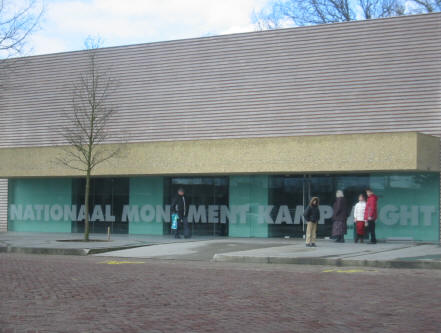
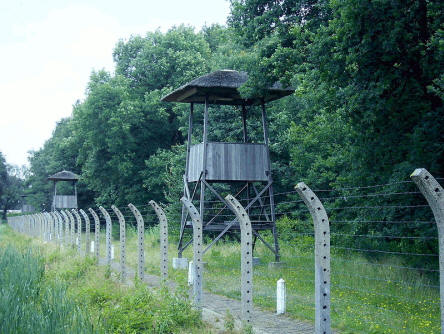
It operated from January 1943 to September 1944 and was known to the Germans as Herzogenbusch. Below left is an example of the barracks and on the right is the memorial site over the crematorium.
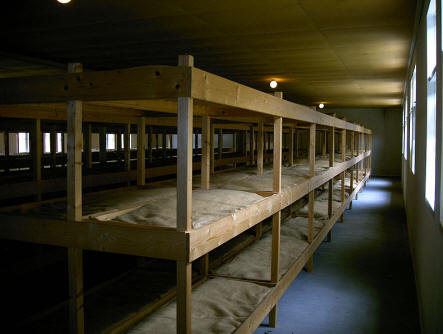
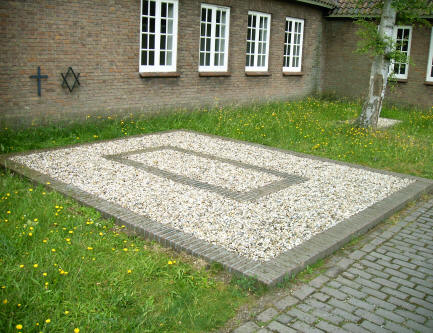
Below are crematoria; on the left is the mobile one and on the right the stationary.
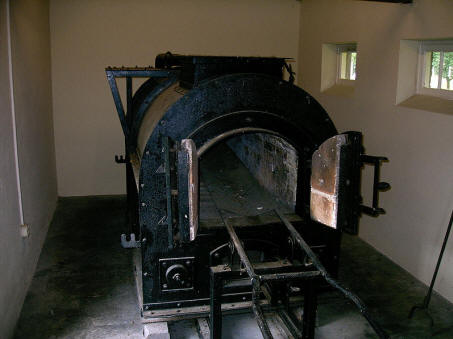
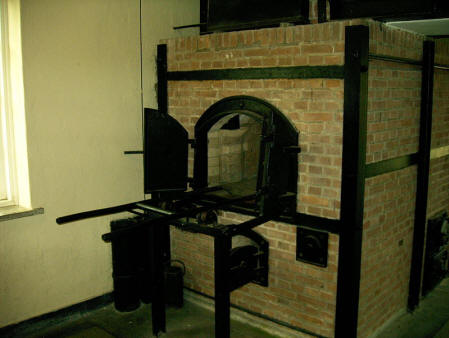
About 30,000 inmates were interned in the complex during this time, of whom
about 12,000 were Jews. In the Netherlands, this camp is known as "Kamp
Vught" [Lunettenlaan 600, Vught,
![]() +31-73-656-6764,] because it was actually located at a heath near the village of
Vught, a few miles south of Den Bosch. What is a tragic coincidence
is that in the 13th Century, the entire Jewish population of 's-Hertogenbosch
was burnt alive on this same heath (pogrom.) Conquered by the Germans in 1940,
the city
was liberated in October 1944 by the British 53rd (Welsh) Division.
+31-73-656-6764,] because it was actually located at a heath near the village of
Vught, a few miles south of Den Bosch. What is a tragic coincidence
is that in the 13th Century, the entire Jewish population of 's-Hertogenbosch
was burnt alive on this same heath (pogrom.) Conquered by the Germans in 1940,
the city
was liberated in October 1944 by the British 53rd (Welsh) Division.
On a lighter note, another
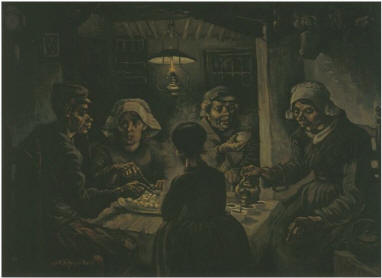 interesting
thing about Brabant is that the famous
interesting
thing about Brabant is that the famous
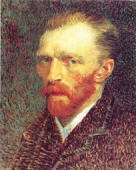 Dutch
painter, Vincent Van Gogh, was born here in the town of
Zundert (south of
Breda) in 1853 and moved to a
nearby town of Neunen
(northeast of Eindhoven) for 2 years, where his father was the church rector.
The two years (1883-5) he spent here was called his Neunen Period and his most
famous painting of that time was "The Potato Eaters"
(above right.) Incidentally,
Dutch
painter, Vincent Van Gogh, was born here in the town of
Zundert (south of
Breda) in 1853 and moved to a
nearby town of Neunen
(northeast of Eindhoven) for 2 years, where his father was the church rector.
The two years (1883-5) he spent here was called his Neunen Period and his most
famous painting of that time was "The Potato Eaters"
(above right.) Incidentally,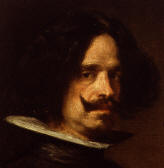 when the Spanish (Philip IV) laid siege to Breda
for 10 months in 1625, the Dutch finally surrendered and the famous Spanish
court painter, Diego Vel�zquez (left,) was there and he later painted the scene
from memory
when the Spanish (Philip IV) laid siege to Breda
for 10 months in 1625, the Dutch finally surrendered and the famous Spanish
court painter, Diego Vel�zquez (left,) was there and he later painted the scene
from memory
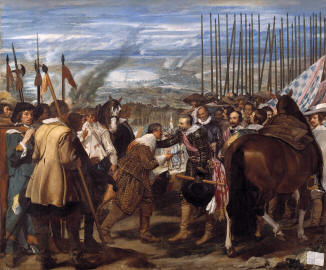
 entitled "The Surrender of Breda" (right) which is now in the Prado
Museum in Madrid.
entitled "The Surrender of Breda" (right) which is now in the Prado
Museum in Madrid.
Also, the city of Oudenbosch
is famous for its smaller replica of the St. Peter's Basilca
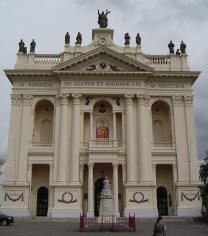 (in Rome) designed
by the architecht Pierre Cuypers I mentioned
earlier in the
Maastricht Diario. When the Zouaves soldiers from here went to defend
Pope Pius IX against Garabaldi (1860-70.) Construction began in 1865
but was not fully completed until 1982. The basilica is unique in the region in
that it is quite large with classical Italian appearance that is atypical for
most of northern Europe, let alone a small village in North Brabant.
Enough on Noord-Brabant, we have to get out of here.
(in Rome) designed
by the architecht Pierre Cuypers I mentioned
earlier in the
Maastricht Diario. When the Zouaves soldiers from here went to defend
Pope Pius IX against Garabaldi (1860-70.) Construction began in 1865
but was not fully completed until 1982. The basilica is unique in the region in
that it is quite large with classical Italian appearance that is atypical for
most of northern Europe, let alone a small village in North Brabant.
Enough on Noord-Brabant, we have to get out of here.
I woke at 3:45 AM, from a vivid dream and then again at 6:55 and again at 7:00. I decided to try and layout a plan for the rest of trip and fell asleep at 8:35. I awoke from another dream at 10:45 and finally got up at 11:55. At 12:15 PM, I went downstairs and had a cappuccino in the hotel lobby. I sat with my computer and did my photos and then backed them all up onto the extra external 1.5 Terabyte (1500 MB) drive I brought with me for just this purpose. I decided that once a week I would pull it out of the trunk and back up the week's new photos.
At 1:15 PM I was able to get online for free and did my email and found out that Herbert van Wallfeld, my old friend from Aachen, Germany had died yesterday. He was President of TechnoMed (Aachen, Germany) and we first met back in 1988 in Toronto at a World Congress of Ophthalmology meeting. I will miss him very much. He was too sick for us to visit him when we were in Aachen in 2007. Though I constantly berated him, he never quit smoking and that had its negative effect.
At 3:00 PM I went upstairs and Marcia and I packed up and carted our bags out. As you can see, our room was fairly spacious.
At 3:15 PM, we checked of out the hotel...
...and then I cajoled Rick, the man on the desk, to let me plug into the business internet they have in their special room (below) and I downloaded Rush and did more AOL email.
At 4:15 PM I took the bags out and loaded the car while Marcia had a coffee in the breakfast area (below left, way back to left of TV.)
At 4:30 PM Marcia drove us back to Den Bosch and she went back to the same place as yesterday (Bagatelle) and at 4:50 PM I started my run heading back to Korte Putstaat where we had dinner last night. The difference was that today it was sunny and nice so I felt a need to take photos in the sun of what I did yesterday. Below are sunnier photos of my start off point at Markt square and one of City Hall.
I finally got to and crossed the Zuid Willemsvaart over the Dommel River with its little boat landing. The river (map below; blue line) merges here with with the Aa stream to form the River Dieze, which subsequently flows into the River Meuse.
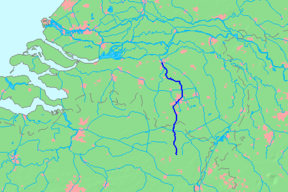
There were many canals and quiet streams along the way.
Near the bridge was this large bronze statue with the inscription "Gedenk die tot der dood getrouw intzicht van tirannieke machten, het vege luften offer brachten opdate de geest verwinnen zou." The translation is roughly "Remember that to death, the faithful removal of tyrannical powers, fatal wind of sacrifice, the spirit will win."
The Wilhelmina bridge gives you a nice view over the Dommel. The two pillars on the bridge were sculptured by Frans van der Burgt (local Dutch sculptor,) built in 1956, which show fragments of the history of Den Bosch.
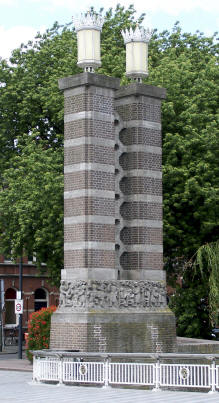
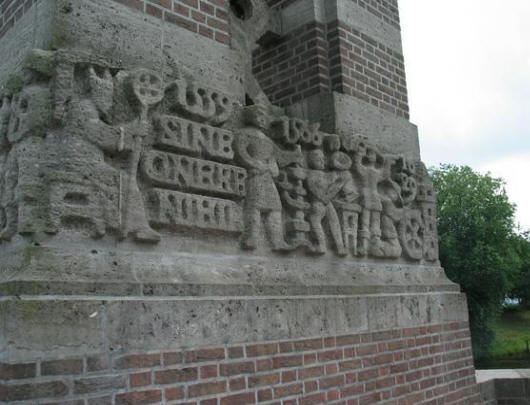
Here is the relief on the north pillar showing history from 1185-1380.
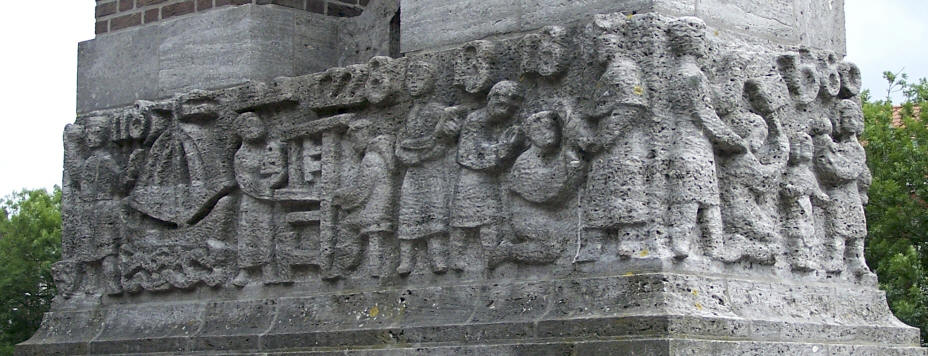
Here is the other relief on the north pillar showing history from 1380-1463.
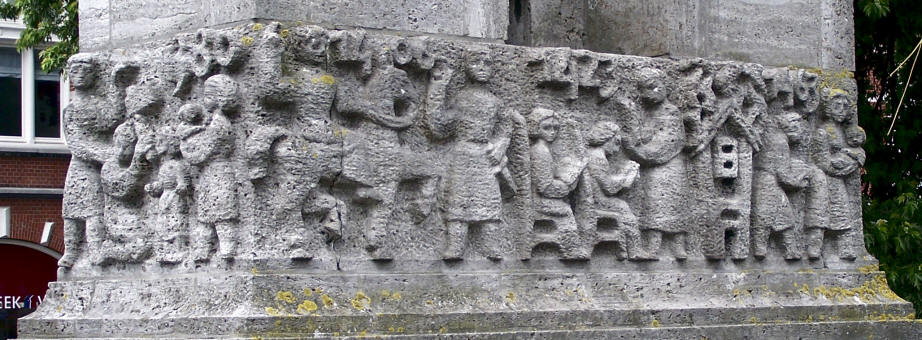
Here is the relief on the south pillar showing history from 1559-1740.
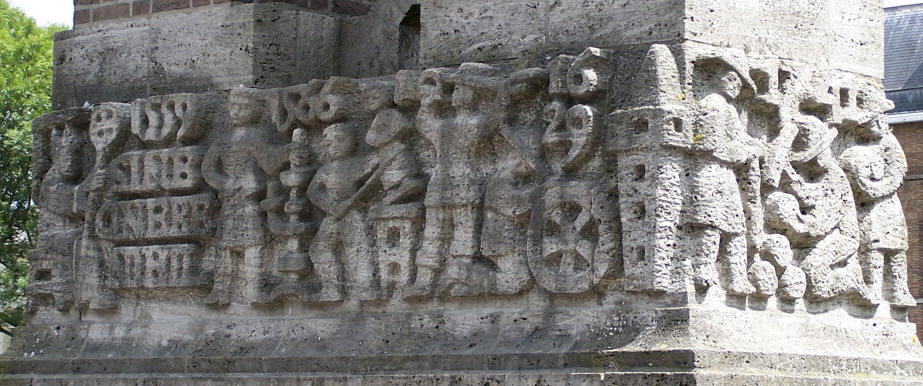
Here is the other relief on the south pillar showing history from 1798-1944.
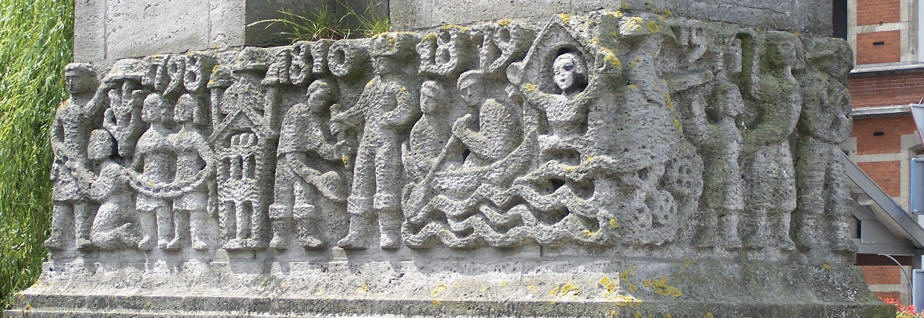
Here are other sculptures by Frans van der Burgt (1915-1985) that are on the Stationstunnel.
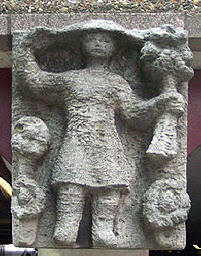
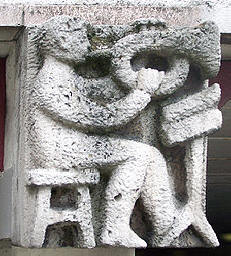
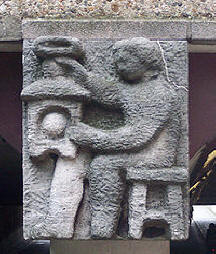
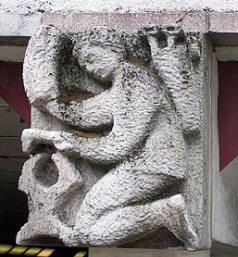
Nearby was a very interesting fountain of whirling disks in the stream. The aluminum art piece on the bridge certainly was pertinent to yesterdays raining.
On the way back I
came
across the Noordbrabants Museum
[Verwersstraat 41,
![]() +31-73
687-7877] (below left) which I didn't have time to go in. Below right is
the house named 'In de Gulde Steur' which is situated on the bridge over the
Dieze River. Today it houses a photo store, but in the old days it was
where the fish market was, before it was moved to the Lepelstraat.
+31-73
687-7877] (below left) which I didn't have time to go in. Below right is
the house named 'In de Gulde Steur' which is situated on the bridge over the
Dieze River. Today it houses a photo store, but in the old days it was
where the fish market was, before it was moved to the Lepelstraat.
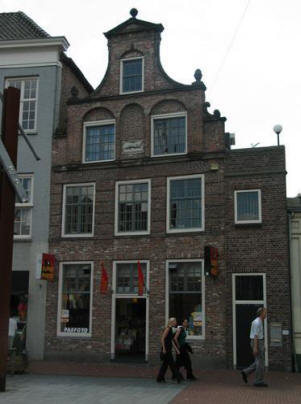
At the end of the Lepelstraat you will find the bridge over the Dieze River. Here you can see this sculpture of a man and a woman (below left.) Den Bosch is also known for its Binnen-Dieze which is a tour boat through the channels and cannels of the city. It is a sort of canal system under the ground.

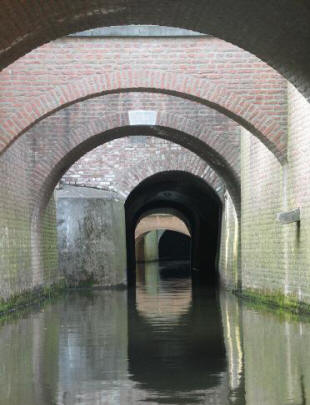
The canal goes through various tunnels all through Den Bosch, many times under the houses.
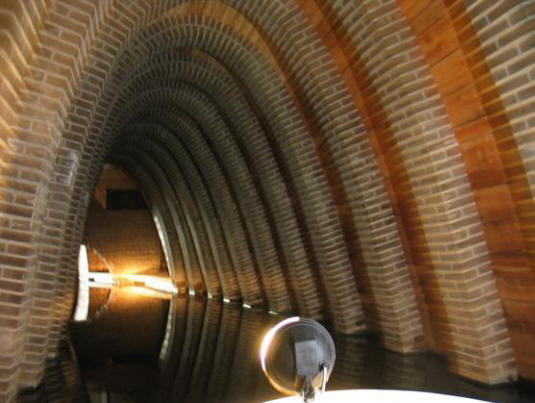
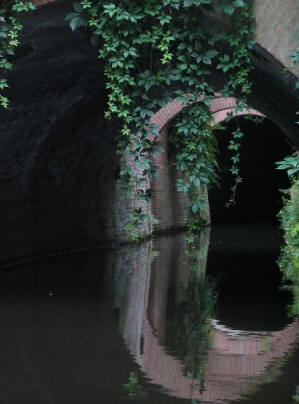
The VVV [77 Markt] (Tourist Center) is housed in the very old building called 'de Moriaan'. It is said to be the first brick building of the Middle Ages. It has recently been restored to its original state and the tourist board has had its home here since the end of the 1960's. At the beginning of the 13th Century, Duke Hendrik I of Brabant gave permission to have the Moriaan built where it now stands.
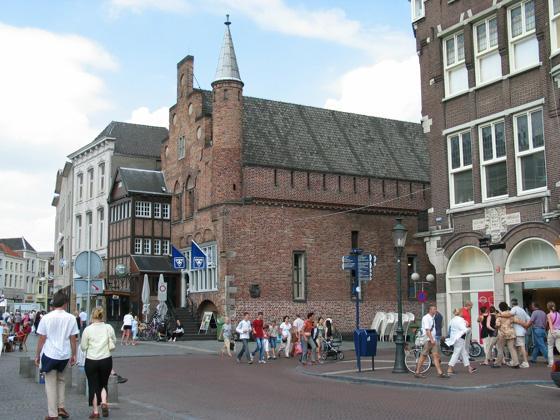
Right in the middle of Markt square there is this little cupola-covered space which is covering a well (below left.) It has been restored just like it was in the Middle Ages. It had previously been replaced by a pump.
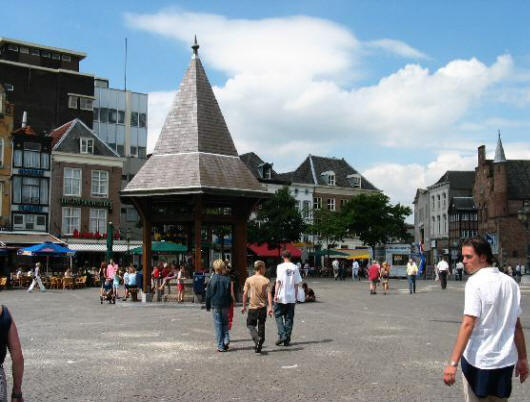
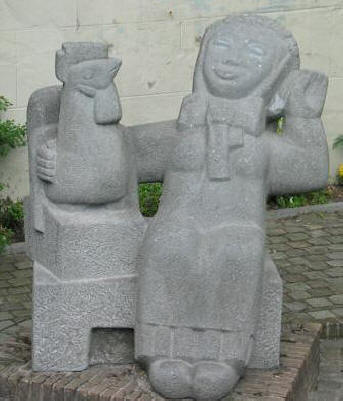
Above right is the "Zoete Lieve Gerritje" or "Dear Sweet Gerritje" who symbolizes the Bossche and Meierijsche spirit, which is good-natured and cheerful. I worked my way through the plaza (below left) and got to our restaurant from last night (below right) and...
...you can see (below) how Korte Putstraat looks much different during the day...
...as it does in this night scene stock photo (below.)
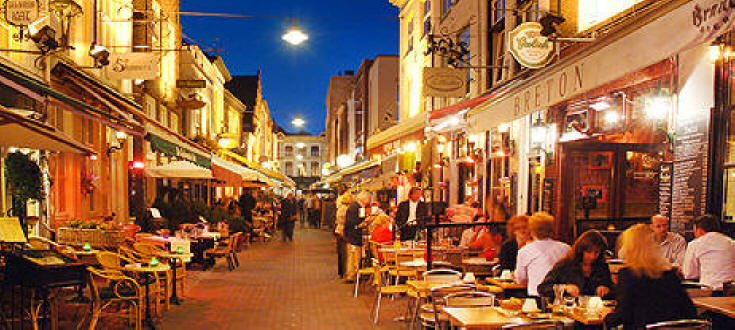
I finally worked my way back to the Markt square.
This time I caught the fish trucks open for business and they had crowds around them. The various fresh and cooked fish looked pretty good.
I then came across the other truck labeled "De Vis en Paling Koning" meaning "The fish and eel king." Boy, this was making me very hungry for some fish.
I got a picture of this interesting architecture (below left) and got another "sunnier" shot of the wall mural I liked.
.jpg)
Back in the center of the square...
...I again had to take photos of Bosch's statue in the sunlight.
I came across this building that looked like a church (below left) but it is the house of the Zwanen brothers who were well known as gourmands and did much for charity. It was built in the 1300s. I then got closer to St. Janskerk which is difficult to photograph from the street I was in (below right.)
Below are some other shots I got from a different angle. You can see the many flying buttresses in the Gothic style.
I came across these signs for Dommelsch bier at the Caf� 't Bonte Palet[Hinthamerstraat 97A, +31-73-613-2532.] It translates as the "colorful pallette."
.jpg)
This is what it looks like down Hinthamerstraat and I came across the finsih line for a skating race (below right.)
Through town I kept seeing these checkered flags everywhere (left,) so I asked
two
police (man and a woman below left) what the flag
was for and pointed to it on the corner building. They looked at me kind
of strange and then at each other and were totally perplexed. They told me
they had no idea. I thanked them and kept going until I saw a man with a
ladder (below right) taking down that flag from his building for the night and
he told me proudly that it is the flag of Brabent. Perhaps the cops were
just having fun with me. Is it possible the police didn't know?
The beautiful church of Sin Jacob, which is now 100 years old, has now become the Museum of Hieronymus Bosch.
Unfortunately their nice large sign describing it is all in Dutch.
.jpg)
It is interesting that they have a model of a whale hanging in the outside foyer (below left.) Outside the church there was this strange art piece (center) which I must believe was based on Bosch's fantasies. As I continued down the street, I came across this perfect shot of waterways alongside the houses (right.)
Then I came across another pretty church with well-preserved statues of the saints. This (below right) was an interesting sign on a building listed as "Palmdoon 1782."
.jpg)
At 5:10 PM, I got a call from Dr. Frans Versteeg, an eye surgeon from Amsterdam. We met by email when he asked me to send him a paper I had published. After I sent it to him, I told him he owed me a beer when I arrived in Amsterdam. I let him know we were approaching the capitol in these days. He told me he would meet us in Amsterdam at the Hotel de l'Europe opposite the Munt tower and that his boat was blue. I was under the impression he was going to take us for a ride through the canals in his boat. I was mistaken, but more on that later. Then at 5:20 PM I bought 2 pins for �4.25 while Marcia got some Dutch postage stamps (below) to send some postcards home.
At 5:30 PM I met Marcia back at the Bagatelle on Hinthamerstraat. Marcia and I both had baguettes with ham, cheese and tomato and they were very good.
.jpg)
When we were finished we headed back to the car and while at 6:10 PM, while driving out of town, we had to stop at the Hinthamerbrug which is a draw bridge and was lifting for boat traffic.
As you cross these bridges in the center of town, you can see all the boat traffic including a boat carrying cars.
As we were driving farther out of town, I got this shot of more modern Dutch housing architecture. We had to cross this very nice bridge on our way. Here is entering the bridge...
...and in the middle (below left) and passing the final suspension links (below right.)
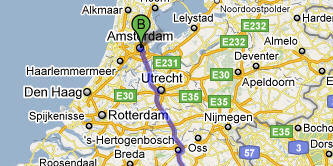
 Marcia drove
straight
Marcia drove
straight
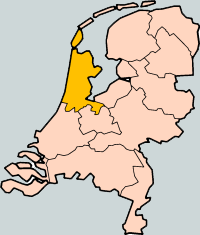 north-northwest
(above) the 55 miles to the city of Amsterdam, the capital of the Netherlands.
We are going here now because I have a course to give at the European Society of
Ophthalmology (SOE)
north-northwest
(above) the 55 miles to the city of Amsterdam, the capital of the Netherlands.
We are going here now because I have a course to give at the European Society of
Ophthalmology (SOE)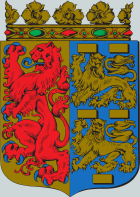 meeting here. On our way, we left Noord-Brabent and passed through the
western panhandle of the province of Gelderland and through the province of
Utrecht to enter Holland for the first time, that is, the provincie of
Noord-Holland (orange
in map
left.) The flag and coat of arms are on the right. This is the
upper half of Holland and is the 6th largest provincie at an area of 1,031 mi2
(2,670 km2) with a population of 2,606,584. Its capitol is the
city of Haarlem (more on that later.) We will return here later in the
summer to thoroughly explore this area in more detail.
meeting here. On our way, we left Noord-Brabent and passed through the
western panhandle of the province of Gelderland and through the province of
Utrecht to enter Holland for the first time, that is, the provincie of
Noord-Holland (orange
in map
left.) The flag and coat of arms are on the right. This is the
upper half of Holland and is the 6th largest provincie at an area of 1,031 mi2
(2,670 km2) with a population of 2,606,584. Its capitol is the
city of Haarlem (more on that later.) We will return here later in the
summer to thoroughly explore this area in more detail.
It is interesting that Google had told me that the trip from Lucerne to Amsterdam would be 520 mi (838 km) and take 7� hours, but it actually was 568 mi and took us 10 hours of driving over a period of 5 days.
The city of Amsterdam (flag
left; coat of arms right) is named by a
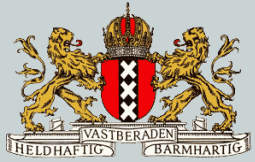
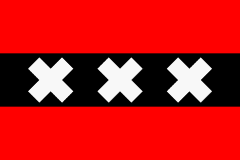 dam
built on the Amstel River (19
mi (31 km) long.) The city, which had a metro population (including
suburbs) of 1.36 million in 2008, comprises the northern part of the Randstad
which consists of the four largest Dutch cities (Amsterdam, Rotterdam, The Hague
and Utrecht) and the surrounding areas (map below left.) With its 7.1
million inhabitants (almost half of the population of the Netherlands) the
Randstad is the 6th largest metropolitan area in Europe. The cities of the
Randstad more or less form a crescent (map below left) giving it its name (rand
= rim or edge and stad = city.) The area that is enclosed by the larger
cities is called the Green Heart (Groene Hart.) The population of the city
itself is only 762,057 and its area is 84.6 mi2 (219 km2)
but almost 25% of it (20.5 mi2 (53 km2)) is water.
dam
built on the Amstel River (19
mi (31 km) long.) The city, which had a metro population (including
suburbs) of 1.36 million in 2008, comprises the northern part of the Randstad
which consists of the four largest Dutch cities (Amsterdam, Rotterdam, The Hague
and Utrecht) and the surrounding areas (map below left.) With its 7.1
million inhabitants (almost half of the population of the Netherlands) the
Randstad is the 6th largest metropolitan area in Europe. The cities of the
Randstad more or less form a crescent (map below left) giving it its name (rand
= rim or edge and stad = city.) The area that is enclosed by the larger
cities is called the Green Heart (Groene Hart.) The population of the city
itself is only 762,057 and its area is 84.6 mi2 (219 km2)
but almost 25% of it (20.5 mi2 (53 km2)) is water.
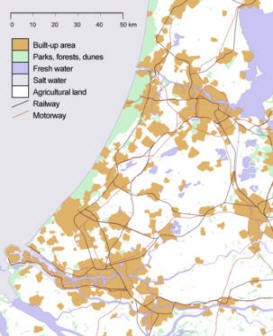
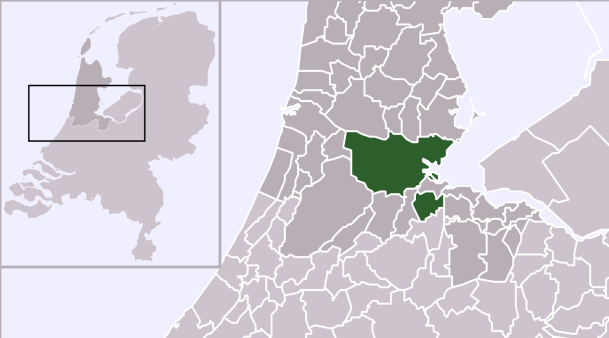
We .jpg) arrived in downtown Amsterdam (map above right) and the GPS got us right to
the hotel after maneuvering the horrendous
traffic of buses, trucks, trams, bicycles and pedestrians. At 7:10 PM we
pulled into the
arrived in downtown Amsterdam (map above right) and the GPS got us right to
the hotel after maneuvering the horrendous
traffic of buses, trucks, trams, bicycles and pedestrians. At 7:10 PM we
pulled into the
![]() little
side alley (Nieuwe Looiersdwars Straat) where the hotel is located and checked into
the
Mercure Amsterdam Arthur Frommer
[Noorderstraat 46,
little
side alley (Nieuwe Looiersdwars Straat) where the hotel is located and checked into
the
Mercure Amsterdam Arthur Frommer
[Noorderstraat 46,
![]() +31-20-622-0328,
H1032@accor.com]
for four nights. Its a neat little place and very convenient.
+31-20-622-0328,
H1032@accor.com]
for four nights. Its a neat little place and very convenient.
We were given room #314, which means we were on the 4th (top) floor (Marcia in the top dormer below left,) which of course also means ...
... we get the slanted ceilings that you keep banging your head on if you are on my side of the room. The room was rather large however, and otherwise very comfortable.
.jpg)
At 8:45 PM we gathered ourselves up and walked the several blocks from the hotel to the place Dr. Franz Versteeg had told us to meet him. On the way, we passed this long line of inline skaters, which seems to be a big thing here. There must have been a couple of hundred of them.
 We finally arrived at the Hotel de l'Europe
[Nieuwe Doelenstraat 2-14,
We finally arrived at the Hotel de l'Europe
[Nieuwe Doelenstraat 2-14,
![]() +31-20-531-1777] at 9:00 PM. Franz said it was right across from the
Munt Tower (Munttoren) or
Mint Tower (below left,) which it was.
+31-20-531-1777] at 9:00 PM. Franz said it was right across from the
Munt Tower (Munttoren) or
Mint Tower (below left,) which it was.
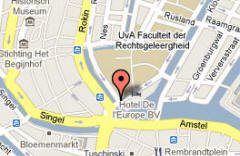 This is a famous magnificent 5-star Old World hotel. We saw there was a
pub inside called Freddy's Bar at the corner of the building but couldn't get in
the main entrance, so we walked around the side and finally found a door to enter.
Surprisingly the place was empty, so we took a nice table in the window.
As you can see this is a really classic old bar and kept in very good condition.
This is a famous magnificent 5-star Old World hotel. We saw there was a
pub inside called Freddy's Bar at the corner of the building but couldn't get in
the main entrance, so we walked around the side and finally found a door to enter.
Surprisingly the place was empty, so we took a nice table in the window.
As you can see this is a really classic old bar and kept in very good condition.
Below left you can see that the outside dining area overlooks the canal. It's funny that the beautifully velvet-curtained main entrance (below right) is kept locked.
I had to order a Heineken (since Amsterdam is where they make it) and Marcia had a
white wine. Our bartender, Gert, was very friendly and told us a lot
of stories. My second glass was in a "Freddy's bar"
glass. Gert told us that Mr. Freddy Heineken bought this hotel and
refurbished it as a flagship for his brewery company. The pub is named after him
and he used to entertain friends and business associates here. Another
interesting story is how the "E"s in Heineken's logo (right) became tilted.
Notice the horizontal line in the letter E on the glass. It should be
perfectly horizontal, but a study he did showed that they sold more beer if they
slanted the line counterclockwise a few degrees and it has thus always been that
way. Gert also served us free salami with pickles.
We also enjoyed a very good sparkling water they have here called Sourcy. Marcia enjoyed the view of the canal from the window seat.
There was a lot of boat activity out there including party boats filled with young people drinking and have a great time.
After an hour of chatting with Gert, and no return call from Franz, we gave up and let Gert recommend a restaurant nearby that is good and might be open. We decided, because of the lateness of the hour, to try it. It was in this interesting building on the corner (below left.) Can you find it in that photo? We had a hard time because it was a little hidden, being that the entrance was rather inconspicuous with only the little sign overhead (below right.)
We had to climb a flight of stairs to get to the restaurant called
Incanto [Amstel 2,
![]() +31-20-423-3681.]
Without reservations (as usual,) we were given a very nice table at the window
over looking the busy intersection (the last empty table in the place.) I
finally got Marcia to really smile, with the Hotel de l'Europe in the
background. It was still pretty light even at 10:30 PM.
+31-20-423-3681.]
Without reservations (as usual,) we were given a very nice table at the window
over looking the busy intersection (the last empty table in the place.) I
finally got Marcia to really smile, with the Hotel de l'Europe in the
background. It was still pretty light even at 10:30 PM.
We first looked at their wine menu (below,) and as you can see, one of my favorite Italian wines, Vernaccia di San Gimignano, was the cheapest on the list at �36 ($51,) which is rather high since we pay no more than $10 for it at home. Marcia and I enjoyed this one by Solo Montenidoli, 2007.
.jpg)
Our waitress brought the wine and we mulled over what we were going to have for dinner.
Here is their menu which is not very extensive. Looking at the prices, just multiply those numbers by 1.41 to obtain the price in US dollars.
.jpg)
.jpg)
They then brought us each an amuse-bouche of lasagna melanzane (eggplant) which was crisp and very tasty even though I am not a big fan of eggplant.
As a starter I had to try my favorite Italian specialty, "Zucca di fiore Judeca" which I learned to love in Rome. Theirs (below) was called Fiori di zucchini ripieno con ricotta affunicata (zucchini flower filled with smoked ricotta cheese.)
I should have had it without the smoked ricotta cheese inside because I did not enjoy it as much as I have in Italy; it was less crispy and too gooey inside. For my secondi, I had paparadella pasta with rabbit and capers (Paparadella al coniglio e capperi) (below left) but it was just way too salty so I asked them to redo it. In 13 minutes, a new plate arrived (below right) which was much better if not a little drier, as can be seen below. They must have just eliminated the sauce. I'm surprised no one else complained. It did not taste like I believe it should have.
Marcia had fish of the day which was red mullet with baby artichokes followed by mixed berries with cream for desert.
I had to get these shots of the urinals in the men's room side by side; on the right is a modern one and on the left is this antique with a faucet to turn to make it flush.
Our dinners were all OK, but not fabulous. Amsterdam has not been lauded for the quality of its restaurants. They gave us a complimentary glass of limoncello (below left) and we got a chance to talk with the owners, Chef Simon, who is from near Venezia, and his wife Claire (below right.) They were very nice but because of the high price of the wine, the zucchini flower and especially the salty (then later dry) main course, I don't think we would go back.
At 12:30, we headed out and walked the several blocks back to the hotel. It was very strange being back in this great city after having last been here in 1974. We got to bed at 1:15 AM.
Kenneth J. Hoffer, MD
Amsterdam, Holland, Netherlands
7-2-2010
If you enjoyed these travels or wish to add comments on the places we visited
Please Leave Me a Message by clicking the spinning @ sign below.

